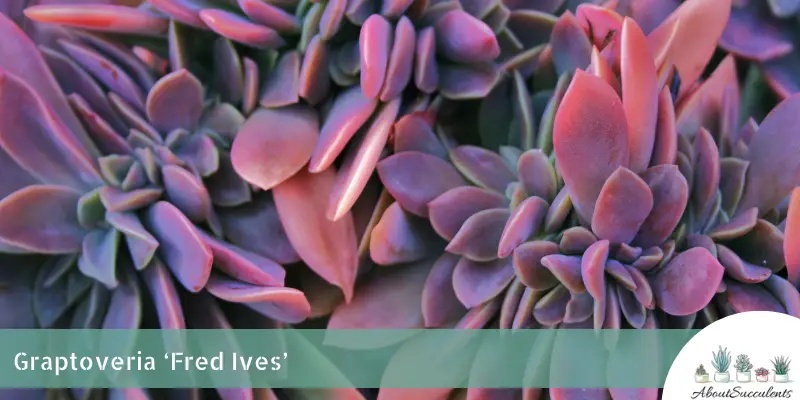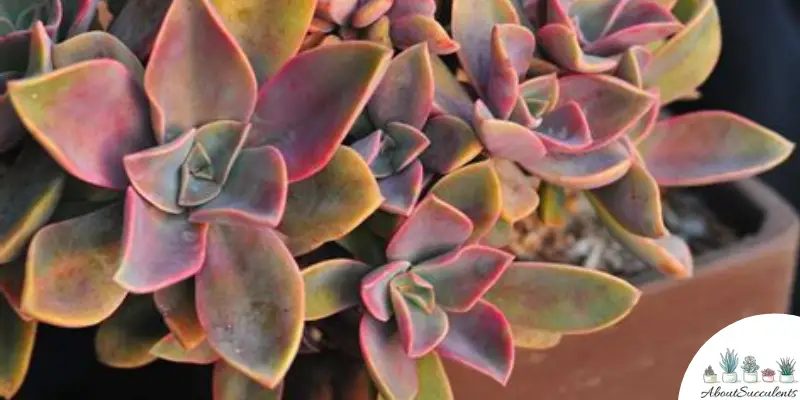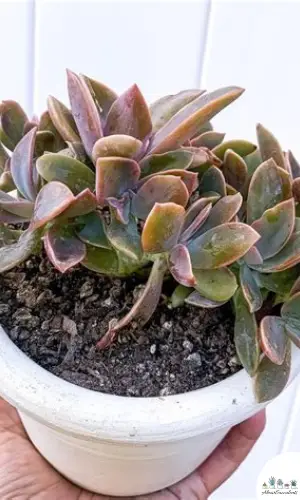
Graptoveria “Fred Ives” is a delightful succulent plant that easily endears horticulturists with its bewildering pinkish-purple leaves that can change into other colors when regularly exposed to sunlight.
This succulent which is sometimes referred to simply as Fred is a hybrid between the Echeveria gibbiflora and the Graptopetalum paraguayense. Fully-grown Fred can reach a height of 20cm (8”) with a diameter of 5cm (2”).
Graptoveria Fred Ives is native to Mexico and is a member of the Crassulaceae family. It blooms pale yellow flowers in the spring that lasts until summer.
General Information:
Also known as: Fred Ives
Plant Family: Crassulaceae
Origin: Mexico
Height: 20cm (8”)
Exposure: Partial or indirect morning sun for 6 hours
Water Needs: Soak and dry method; give soil a good soaking once it’s completely dry.
Soil Type: Standard soil potting mix with peat, sand, or perlite to improve drainage.
Soil pH: 6.5 to 7.5
How to Grow and Care for Graptoveria Fred Ives

Aside from being a type of succulent that’s easy to grow and care for, Graptoveria Fred Ives is very resilient and durable.
Fred is a good choice to start a hobby growing succulents. As long as you give it the right amount of sunlight, water, and good quality of soil, Fred will be alright.
Sunlight
If you want Graptoveria Fred Ives to adorn your garden, place it in a location that gets 6 hours of full to partial morning sunlight every day.
As resilient and durable as Fred is, this succulent plant is not cold-hardy. If your region’s temperature drops below -6.7° C (20° F), transfer Graptoveria Fred Ives into a ceramic pot with a drain hole and move it indoors.
Place Fred near a window that received 4 to 6 hours of partial sunlight every day. If getting regular sunlight is a problem, place the plant under a Grow Light.
Watering

The great thing about Graptoveria Fred Ives is that it doesn’t require regular watering. The succulent plant grows better if it receives water only when the soil is 100% dry.
If you want to know when it’s time to water the soil, insert a stick an inch into the topsoil. Pull out the stick and if it’s dry to the touch, give the soil a good soaking.
The rule of thumb is to water frequently in the summer and considerably less in the winter.
Pot and Soil
The best pot to grow Graptoveria Fred Ives in is one that is made of either ceramic or terracotta because these materials support the proper evaporation of moisture from the soil.
Regardless of your choice of pot, it must always have a drain hole with a mesh cover. Fred’s roots are very sensitive to moisture. If the roots are kept in a moist environment for a long period of time, they will rot.
Graptoveria Fred Ives will thrive in a standard potting soil mix that has peat, perlite, and sand to further improve drainage.
How to Propagate Graptoveria Fred Ives
Another reason why Graptoveria Fred Ives is popular with hobbyists is that it’s a type of succulent plant that’s easy to propagate. You have 3 methods of propagation to choose from: Cuttings, Seeds, or Offsets.
Method 1 – Leaf Cuttings
Step 1: Select a healthy leaf or one that has no signs of discoloration.
Step 2: Perform a twist and pull to remove the leaf from the stem. You can also cut the leaf off by using a sterilized and sharpened pair of gardening scissors. Make sure there’s no part of the leaf on the stem to ensure successful propagation.
Step 3: Let the leaf cuttings dry for up to 3 days. When the leaves are dry, they will develop hard calluses.
Step 4: Place the callused leaf cuttings on top of well-draining soil.
Step 5: Lightly mist the soil when it’s completely dry.
Method 2 – Seeds
Step 1: Plant the seeds in warmer temperatures.
Step 2: Make sure you plant the seeds in soil that has good drainage.
Step 3: Water the soil when it’s completely dry and place the pot in an area that gets partial sunlight to speed up the germination process.
Method 3 – Offsets
Step 1: Fred will produce offsets at the main stem.
Step 2: Cut off the offsets by using a sterilized and sharpened pair of gardening scissors.
Step 3: Allow the offsets to dry out and develop calluses. This may take 3 days.
Step 4: Place the offsets on top of well-draining soil.
Step 5: Check the soil for dryness before giving it water.
Frequently Asked Questions
Is Graptoveria Fred Ives Toxic to Cats and Dogs?
Graptoveria Fred Ives does not appear on the list of plants that are toxic to cats and dogs on the website of the American Society for the Prevention of Cruelty to Animals (ASPCA).
Why Is My Graptoveria Fred Ives Dying?
If your Graptoveria Fred Ives is dying, it could be because it was given too much water or the succulent is infested with deadly pests.
Read our tips on how to keep Fred from dying. There might still be time to save your beloved succulent plant.
Overwatering
If the soil of Graptoveria Fred Ives is still moist, don’t give water because that will lead to root rot. Overwatering is the number one killer of succulents. The primary symptom is discoloration of the leaves or stem.
If you notice the leaves or the steam turn into a darker shade of yellow or blackish-brown, this is a clear sign that fungal infection is taking place.
Get a pair of sharpened garden scissors and remove the infected parts immediately. Then, remove the plant from the soil and inspect the roots. Remove the infected roots as well and leave Fred to dry out in a warm area.
Fill a pot with a fresh batch of standard soil mix and replant Fred in its new home.
Pest Infestation
Insects such as mealybugs, aphids, and spider mites can contribute to the demise of Fred by depriving it of nourishing sap.
Spray Graptoveria Fred Ives with neem oil or wipe the leaves with insecticide soap to get rid of infectious pests.
Does Graptoveria Fred Ives Produce Flowers?
Graptoveria Fred Ives produces pale yellow flowers in the springtime. The flowers will last until the end of summer.
Last Updated on June 9, 2022 by Sofia Lara